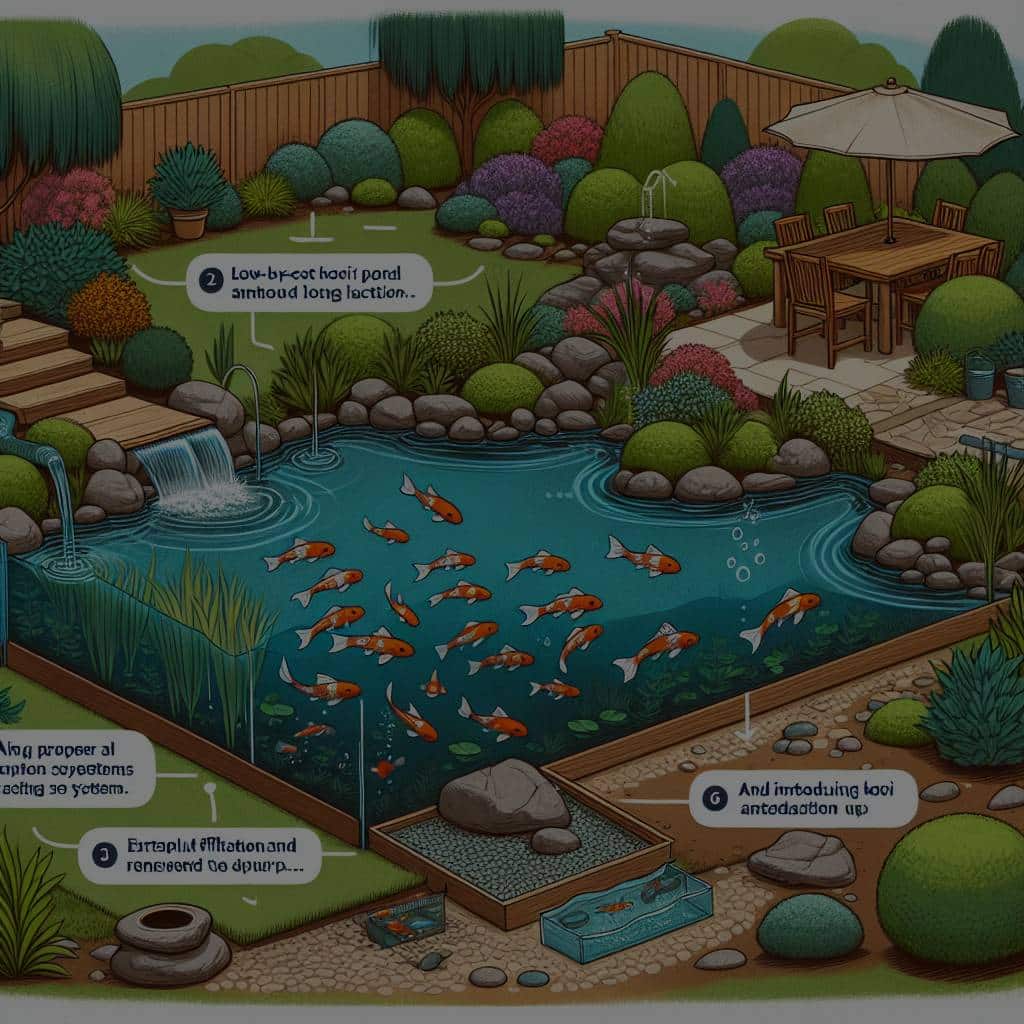How Can You Construct a Low-Cost DIY Koi Pond for a Tranquil Backyard Feature?

A tranquil backyard is more than just a place to unwind – it’s a personal retreat filled with relaxation, peace, and serenity. Imagine a picturesque pond, with the sound of a gentle waterfall, the sway of aquatic plants, and the graceful dance of koi fish. The addition of a pond will transform your outdoor space into a private haven. In this article, we provide a comprehensive guide on how to build a cost-effective DIY koi pond that can add a touch of tranquility to your backyard.
PLANNING YOUR KOI POND
Before you break ground, preparation will be crucial to the success of your project. Firstly, consider the location. You should place your pond where it will get some shade to prevent water temperature from becoming too high for your koi. Also, avoid areas with large trees, as roots and falling leaves could become a challenge.
Topic to read : How Can You Design a Stylish and Safe Staircase for Seniors with Mobility Concerns?
Once you’ve settled on the location, think about the size and depth of your pond. An ideal koi pond should be at least three feet deep. This depth can provide the koi with protection from predators and help maintain temperature stability.
When planning your pond’s aesthetic look, picture the type of waterfall you’d like to build and the various plants you’d want to add to create a natural habitat for your koi.
Also read : What Are the Best Solutions for Creating a Hidden Home Office in a Bookshelf Wall?
GATHERING THE MATERIALS
To build a pond, you will need a pond liner, a pump, some rocks and gravel, a filter and some PVC piping.
The pond liner is crucial, as it will prevent water from seeping into the ground. Choose a durable and puncture-resistant liner. PVC liners are affordable and offer good durability.
The pump is essential for water circulation. It will keep your water moving, preventing stagnation and promoting the health of your koi. Choose a pump that fits the size of your pond.
Rocks and gravel will add to the natural aesthetic of your pond and provide useful bacteria that aid in filtering the water.
The filter will keep your water clear and clean. It’s a vital component in maintaining the health of your fish.
PVC piping is used to connect the pump to the waterfall and the filter.
DIGGING AND INSTALLING THE POND LINER
Once you have your plan and materials, it’s time to start digging. Dig the hole according to your desired shape and depth.
After digging, install the pond liner. Lay it across the hole and secure it with rocks. Make sure to leave some excess liner around the edges to cover with soil and rocks later.
Remember to be careful not to puncture the liner while installing it and check for any leaks before proceeding.
SETTING UP THE PUMP AND FILTER
The pump and filter are essential parts of your pond – they ensure that the water remains clean and safe for your koi.
The filter should be placed in an area where the water can easily flow into it. The pump, on the other hand, should be located opposite the filter, to ensure proper circulation of water throughout the pond.
Connect the pump to the filter and the waterfall using the PVC pipes. Ensure that all connections are tight and secure, to prevent any leaks.
INTRODUCING PLANTS AND FISH
Now that the infrastructure of your pond is set, it’s time to bring it to life. Adding plants and fish to your pond will enhance its appeal and create a natural, balanced ecosystem.
Choose plants that are suitable for pond conditions and beneficial for koi. Some good options include water lilies, lotus, and hornwort. These plants not only add beauty to the pond but also provide shade for the koi and help maintain water quality.
After the plants, it’s time to introduce the koi. Before adding them into your pond, it’s advisable to let them acclimate to the water temperature in their bag first, to prevent shock.
CREATING A WATERFALL
The waterfall is the finishing touch to your pond. Not only does it add a sublimely soothing sound to your backyard, but it also oxygenates the water, which supports the health of your fish.
Creating a waterfall involves stacking rocks in a way that allows water to flow freely over them. The pump will push the water up to the top, and gravity will allow it to cascade down.
Remember to choose rocks that complement the overall look of your pond, and to secure them properly to avoid any collapses.
Creating a low-cost DIY koi pond is not a weekend project. It requires patience and dedication. But the result will be well worth the time and effort when you gaze upon your very own tranquil backyard feature, teeming with life and overflowing with serenity.
MAINTAINING YOUR KOI POND
Keeping your tranquil water feature in optimal condition requires regular maintenance. Your koi pond’s health and longevity depend on your commitment to its upkeep.
Firstly, monitor the water quality. Koi fish are highly dependent on the quality of their water environment. Poor water quality can lead to sickness and even death. Regular testing can help you maintain the right balance of pH, ammonia, nitrate, nitrite, and other necessary elements.
Secondly, pay attention to the physical condition of your pond. Regularly remove any debris such as leaves, twigs, and dirt. These could block the filter or pump, affecting the water quality and the health of your koi fish. Also, regularly inspect the pump and filter for any damage or blockages.
Thirdly, maintain the health of your koi. Monitor their eating habits, their activity levels, and their general health. If you notice any changes, it might indicate a problem, such as disease or stress.
Lastly, seasonal care is essential. In winter, use a de-icer to keep a portion of the pond’s surface from freezing, allowing for gas exchange. During spring, clean up your pond thoroughly to get rid of any debris accumulated over winter.
In essence, maintaining your koi pond requires regular effort. However, the reward of having a tranquil backyard pond filled with healthy, vibrant koi fish is genuinely worth it.
CONCLUSION: THE JOY OF YOUR DIY KOI POND
Building a DIY koi pond is a rewarding project that enhances your outdoor space’s beauty and tranquility. From designing your water garden to digging and filling it, every step is an opportunity for creativity and personal fulfillment. Watching your backyard transform into a serene sanctuary, complete with the soothing sound of a pond waterfall, vibrant aquatic plants, and the elegant dance of koi fish, is a truly satisfying experience.
While it requires time, effort, dedication, and a bit of a budget, the end result is incomparable. Not just a water feature, your koi pond is a testament to your skill, creativity, and love for nature. Regular maintenance ensures that your garden pond remains a thriving and tranquil oasis for years to come.
Whether you’re a skilled DIYer or a beginner, the process of creating a koi pond is certainly achievable. Use these guidelines as a starting point and let your creativity flow. Remember, this is your tranquil retreat, so design your pond to suit your taste and match the aesthetic of your garden.
Ultimately, the joy of sitting by your own DIY pond, watching the koi glide gracefully beneath the lily pads, listening to the gentle cascade of the waterfall, all in the comfort of your own backyard, is an experience that is well worth the effort. So why wait? Transform your outdoor space into a peaceful haven with your own DIY koi pond today!
